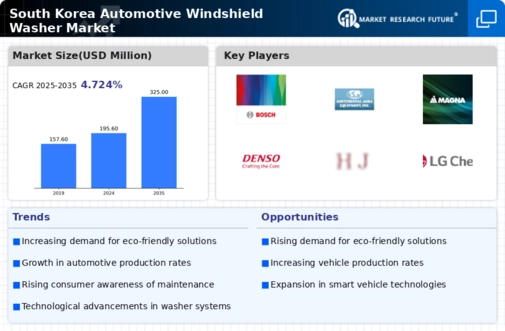Rising Vehicle Production
The automotive windshield-washer market in South Korea is experiencing growth due to the rising vehicle production rates. In recent years, South Korea has established itself as a significant player in the automotive industry, with production figures reaching approximately 4 million units annually. This increase in vehicle manufacturing directly correlates with a heightened demand for essential components, including windshield-washers. As manufacturers strive to enhance vehicle safety and performance, the integration of advanced windshield-washer systems becomes paramount. Consequently, the automotive windshield-washer market is likely to benefit from this upward trend in vehicle production, as more vehicles on the road necessitate efficient and reliable washing systems.
Growth of Electric Vehicles
The automotive windshield-washer market is poised for transformation. This transformation is linked to the growth of electric vehicles (EVs) in South Korea. As the government promotes the adoption of EVs through incentives and infrastructure development, the automotive industry is witnessing a shift towards electric mobility. This transition presents unique opportunities for the automotive windshield-washer market, as EVs often require specialized components to optimize performance and efficiency. Manufacturers are likely to innovate and develop windshield-washer systems tailored for electric vehicles, focusing on energy efficiency and sustainability. As the EV market expands, the automotive windshield-washer market may experience a corresponding increase in demand for advanced washing solutions that align with the eco-friendly ethos of electric mobility.
Impact of Weather Conditions
The automotive windshield-washer market in South Korea is notably affected by the country's diverse weather conditions. With distinct seasons, including heavy rainfall and snowfall, the demand for efficient windshield-washer systems becomes critical. During the rainy season, the need for effective visibility solutions drives consumers to prioritize high-quality windshield-washers. Furthermore, the winter months necessitate the use of specialized washer fluids that can withstand low temperatures. This seasonal variability in weather patterns creates a dynamic market environment, where manufacturers must adapt their offerings to meet the changing needs of consumers. Consequently, the automotive windshield-washer market is likely to see fluctuations in demand based on these climatic factors.
Regulatory Compliance and Standards
The automotive windshield-washer market is significantly influenced by stringent regulatory compliance and safety standards in South Korea. The government has implemented various regulations aimed at ensuring vehicle safety and environmental protection. For instance, the Ministry of Land, Infrastructure and Transport mandates that all vehicles must be equipped with effective windshield-washer systems to enhance visibility during adverse weather conditions. This regulatory framework not only drives the demand for high-quality windshield-washers but also encourages manufacturers to innovate and improve their products. As a result, the automotive windshield-washer market is poised for growth as companies adapt to these evolving standards and consumer expectations.
Consumer Preference for Advanced Features
In South Korea, there is a noticeable shift in consumer preferences towards vehicles equipped with advanced features, including sophisticated windshield-washer systems. Modern consumers are increasingly seeking vehicles that offer enhanced safety, convenience, and performance. This trend is reflected in the automotive windshield-washer market, where demand for features such as automatic washing systems and heated washer fluid is on the rise. According to recent surveys, approximately 60% of consumers express a preference for vehicles with advanced windshield-washer technologies. This growing inclination towards innovation is likely to propel the automotive windshield-washer market, as manufacturers respond to consumer demands by integrating cutting-edge technologies into their products.





















Leave a Comment